
Publisher:
Bonnie King
CONTACT:
Newsroom@Salem-news.com
Advertising:
Adsales@Salem-news.com

~Truth~
~Justice~
~Peace~
TJP
Jun-01-2012 21:18

 TweetFollow @OregonNews
TweetFollow @OregonNews
Temple of Tamil Folk Heritage in Sri Lanka Found Destroyed, Desecrated
Salem-News.comJaffna University History Department surveyed and documented damage to the temples in the resettled parts of the HSZ in Valikaamam North.
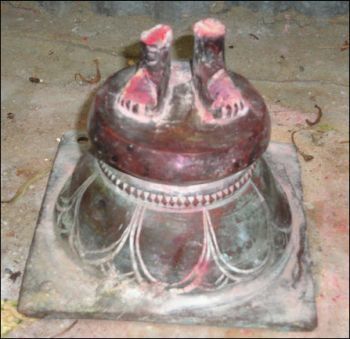 The rare bronze image of the deity Kooddaththaar found sawed off in the Sinhala Army-occupied ‘High Security Zone’ at I'lavaalai in Jaffna. The image of the collective deity of the Tamil guild of soldiers of the ancient times, was in anthropomorphic form. Note that despite the idol missing, the local Tamil devotees have applied saffron in reverence to the the remaining part. [Image courtesy: History Department, University of Jaffna] |
(JAFFNA, Sri Lanka TamilNet) - A unique temple of Eezham Tamil folk heritage, dedicated to Kooddaththaar, a deity historically worshiped by a soldier guild that got absorbed into the toddy-tapping community, was found destroyed in bombing and its rare bronze idol sawed off and stolen at the Vasanthapuram locality of I’lavaalai in Jaffna.
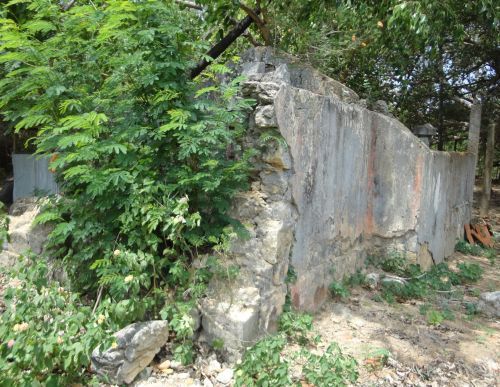 Destroyed and delapidated walls of the Kooddaththaar Temple in the Sri Lanka occupied 'High Security Zone' at I'lavaalai [Image courtesy: History Department, University of Jaffna] |
For the last two decades the locality was under the ‘High Security Zone’ (HSZ) of the occupying Sinhala military.
Recently, when some fringes of the HSZ were allowed for resettlement, the people of Vasanthapuram returned. Finding their temple destroyed and the deity missing they now worship only the pedestal remaining.
Vasanthapuram is where the occupying military has built lines of a few monotype houses for the resettled people and often shows them off to visiting foreign dignitaries as an example of its ‘reconciliation’ efforts.
The destruction and desecration of the Kooddaththaar temple was brought to light when a media team from Virakesari led by Ms Uma Prakash, joining with Professor P. Pushparatnam and Ms Sasitha Kumaradevan of the Jaffna University History Department, undertook a survey and documentation of the temples in the resettled parts of the HSZ in Valikaamam North.
Writing a feature in Virakesari on Sunday, Professor Pushparatnam elucidated on the historical, religious and social significance behind the heritage of the temple.
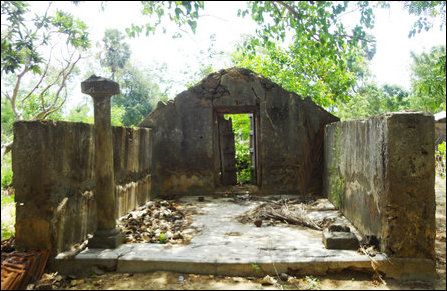 The Kooddaththaar Temple of I'lavaalai, found destroyed in the ‘High Security Zone’ occupied by the Sinhala Army in the last two decades [Image courtesy: History Department, University of Jaffna] |
Bringing out the present conditions in the locality, he said that areas interior to the main roads are beyond recognition with scrub jungle and ruined buildings.
He records an interesting observation that the emotional priority of the resettled people is to first rebuild their temples than to rebuild their houses.
Noting that the coral-stone-built Kooddaththaar temple was one of the many structures destroyed in bombing during the war, and noting that besides the main bronze image there were also other images missing from the temple, Pushparatnam says, people have now placed stones to represent the various other deities and worship them.
The bronze image of the deity Kooddaththaar was in anthropomorphic form with just two hands wielding weapons, Pushparatnam cited an old-generation person earlier associated with the temple.
In explaining the cult of Kooddaththaar, Pushparatnam cited Dr. P. Ragupathy assigning it to the hero-worship cult of the soldier guilds.
When contacted by TamilNet, Dr. Ragupathy said Kooddaththaar, A’n’namaar, Cheavukar and Padaikkalar found in the folk religion of Eezham Tamils are deities of collective hero-worship, originating from the soldier guilds of historical times.
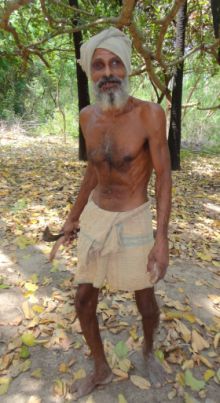 Mr Naakan, caretaker and folk-priest (Poochaari) of the Kooddaththaar Temple at I'lavaalai, Jaffna [Image courtesy: History Department, University of Jaffna] |
The collectiveness in the concept could be seen in the plural form used for the names of the deities: Kooddaththaar (members of the guild), A’n’namaar (from A’n’nalmaar, meaning leaders or those who have become gods), Cheavukar (soldiers), Padaikkalar (those who wield weapons), he pointed out.
Collectiveness of a community personified into a deity is an alternative idea of religion found only at folk levels, he further said.
The soldier guilds, associated with the protection of trade guilds and rulers of the past, were also cultivators or craftsmen in peacetimes.
In the medieval times, especially in the late medieval times, they were also hired and migrated to far and wide places in South and Southeast Asia. With the collapse of native trade and state institutions, the soldier guilds were absorbed into various castes and professions.
Vaiyaa-paadal, a historiographical literature of the times of the Kingdom of Jaffna lists the names of a number of soldier groups that have come to Jaffna from various parts of South Asia and even from West Asia and Africa.
The literature also notes the absorption of some of them into certain castes. The same phenomenon and associated religious cults could be found in the Sinhala heritage too.
Ragupathy, citing his teacher the late Mr T. Shanmugasundaram a doyen of Eezham Tamil folklore, said that the deity Kooddaththaar was worshipped by Paa’laik-kaththip-pa’l’lar who got absorbed into the caste of Na’lavar, engaged in toddy-tapping today.
According to Yaazhppaa’na Vaipava Maalai, a historiographical work of the Dutch times, another soldier guild called Kaththikkaara-nampika’l was also absorbed into the Na’lavar community.
Usually, temples for Kooddaththaar are found in the settlements of Na’lavar community and A’n’namaar temples are found in the settlements of Pa’l’lar community in Jaffna.
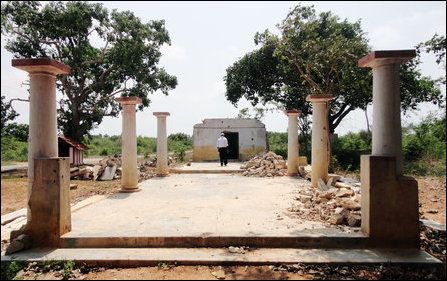 Another nearby temple for Vayiravar found destroyed in bombing in the HSZ, I'lavaalai [Image courtesy: History Department, University of Jaffna] |
Mr. N. Rajaratnum, a Jaffna University graduate coming from a nearby place of Vasanthapuram and now living in Montreal, told TamilNet that the locality of the Kooddaththaar temple was actually called Chingkaththin-kaadu and not Vasanthapuram.
Vasanthapuram is a modern name given in the late 1950s to a colony for landless people started at a nearby place then called Pokka’naik-kaadu, Rajaratnam said.
According to him, in the 1980s the patrons of the Kooddaththaar temple were just around 15 families of the Na’lavar community, but they all were traditionally owning land there.
At a close-by distance, in a locality called Ma’nal Adaippu, there was an A’n’namaar temple and a settlement of the Pa’l’lar.
Animal sacrifice used to take place in both the temples.
The sacrifice at the Kooddaththaar temple took place on the 8th day of the festival of Kava’naavaththai Vayiravar temple, which was then well known for animal sacrifice.
The practice has been stopped in all the folk temples of the surroundings a few decades ago, Rajaratnam further said.
 |
 |
 |
 |
 |
 |
 |
Articles for May 31, 2012 | Articles for June 1, 2012 | Articles for June 2, 2012
Quick Links
DINING
Willamette UniversityGoudy Commons Cafe
Dine on the Queen
Willamette Queen Sternwheeler
MUST SEE SALEM
Oregon Capitol ToursCapitol History Gateway
Willamette River Ride
Willamette Queen Sternwheeler
Historic Home Tours:
Deepwood Museum
The Bush House
Gaiety Hollow Garden
AUCTIONS - APPRAISALS
Auction Masters & AppraisalsCONSTRUCTION SERVICES
Roofing and ContractingSheridan, Ore.
ONLINE SHOPPING
Special Occasion DressesAdvertise with Salem-News
Contact:AdSales@Salem-News.com
googlec507860f6901db00.html




Terms of Service | Privacy Policy
All comments and messages are approved by people and self promotional links or unacceptable comments are denied.
[Return to Top]
©2025 Salem-News.com. All opinions expressed in this article are those of the author and do not necessarily reflect those of Salem-News.com.